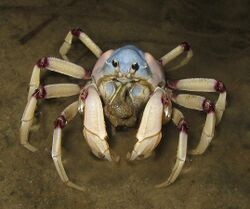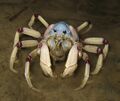Biology:Mictyris
From HandWiki
Short description: Genus of crabs
| Mictyris | |
|---|---|

| |
| Light-blue soldier crab, Mictyris longicarpus | |
| Scientific classification | |
| Domain: | Eukaryota |
| Kingdom: | Animalia |
| Phylum: | Arthropoda |
| Class: | Malacostraca |
| Order: | Decapoda |
| Suborder: | Pleocyemata |
| Infraorder: | Brachyura |
| Superfamily: | Ocypodoidea |
| Family: | Mictyridae Dana, 1851 |
| Genus: | Mictyris Latreille, 1806 |
Mictyris is a genus of brightly coloured crabs, placed in its own taxonomical family, the Mictyridae.[1] It inhabits the central Indo-West Pacific region. These crabs congregate on mud flats or beaches in groups of a few thousand, and filter sand or mud for microscopic organisms. They congregate during low tide, and bury themselves in the sand during high tide or whenever they are threatened. This is done in wet sand, and they dig in a corkscrew pattern, leaving many small round pellets of sand behind them.
Species
The genus contains eight species:[1][2][3][4]
| Image | Scientific name | Distribution |
|---|---|---|
 |
Mictyris brevidactylus Stimpson, 1858 | Japan, China (including the type location, Hong Kong), Taiwan, Singapore, and parts of Indonesia (Karakelong, Bawean and Ambon Island) |
| Mictyris darwinensis Unno & Semeniuk, 2011 | Australia(Kimberley to Cape York) | |
| Mictyris guinotae Davie et al., 2010 | Ryukyu Islands of Japan | |
| Mictyris livingstonei McNeill, 1926 | Australia | |
 |
Mictyris longicarpus Latreille, 1806 | Bay of Bengal to New Caledonia and Australia |
| Mictyris occidentalis Unno, 2008 | Australia(King Bay, Dampier Archipelago) | |
| Error creating thumbnail: Unable to save thumbnail to destination | Mictyris platycheles H. Milne-Edwards, 1852 | Tasmania and Australia(Victoria to Queensland) |
| Mictyris thailandensis Davie, Wisespongpand & Shih, 2013 | Thailand |
The predictable behaviour of these crabs has led them to be used in experiments in a form of billiard ball computer.[5][6]
References
- ↑ 1.0 1.1 Peter K. L. Ng; Danièle Guinot; Peter J. F. Davie (2008). "Systema Brachyurorum: Part I. An annotated checklist of extant Brachyuran crabs of the world". Raffles Bulletin of Zoology 17: 1–286. http://rmbr.nus.edu.sg/rbz/biblio/s17/s17rbz.pdf.
- ↑ Peter Davie (2010). "Mictyris Latreille, 1806". WoRMS. World Register of Marine Species. http://www.marinespecies.org/aphia.php?p=taxdetails&id=439492.
- ↑ Peter J. F. Davie; Hsi-Te Shih; Benny K. K. Chan (2010). "A new species of Mictyris (Decapoda, Brachyura, Mictyridae) from the Ryukyu Islands, Japan". Studies on Brachyura: a Homage to Danièle Guinot. pp. 83–105. doi:10.1163/ej.9789004170865.i-366.61. ISBN 9789047424178. http://decapoda.nhm.org/pdfs/31484/31484.pdf.
- ↑ Unno, J.; Semeniuk, V. (2011). "A new species of Mictyris (Crustacea: Decapoda: Brachyura: Mictyridae) recorded from northern Australia Kimberley region to Cape York". Journal of the Royal Society of Western Australia 94: 45–54. https://www.rswa.org.au/publications/Journal/94(1)/UnnoSemeniukpp.45-54.pdf.
- ↑ Jacob Aron (April 12, 2012). "Computers powered by swarms of crabs". New Scientist. https://www.newscientist.com/blogs/onepercent/2012/04/researchers-build-crab-powered.html.
- ↑ Yukio-Pegio Gunji; Yuta Nishiyama; Andrew Adamatzky (2011). "Robust soldier crab ball gate". Complex Systems 20: 2. Bibcode: 2012arXiv1204.1749G.
External links
Wikidata ☰ Q1318121 entry
 |

